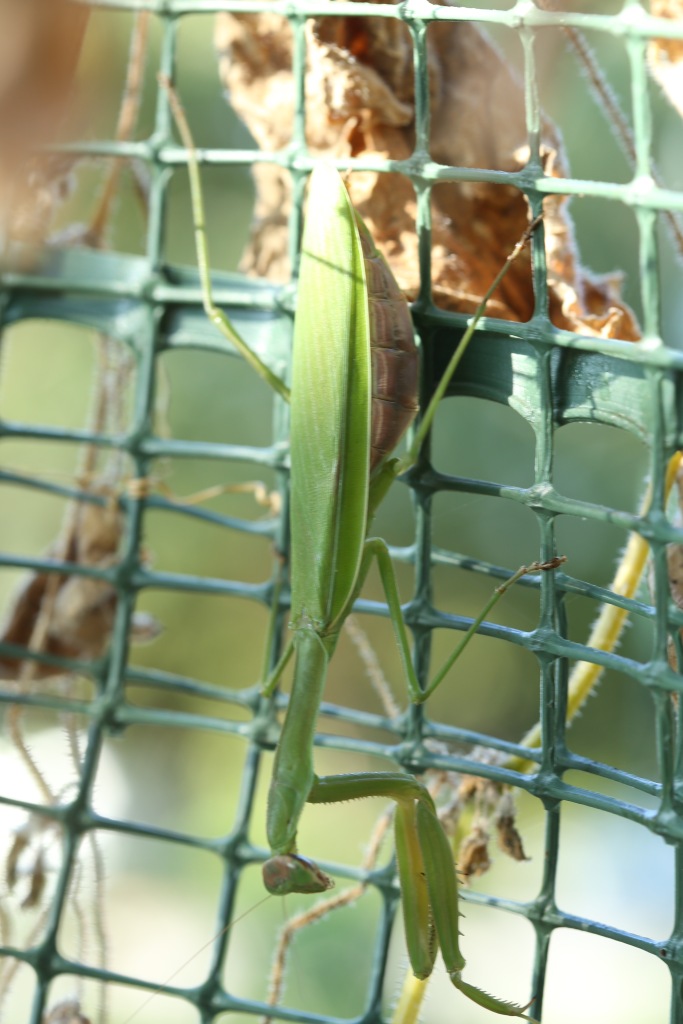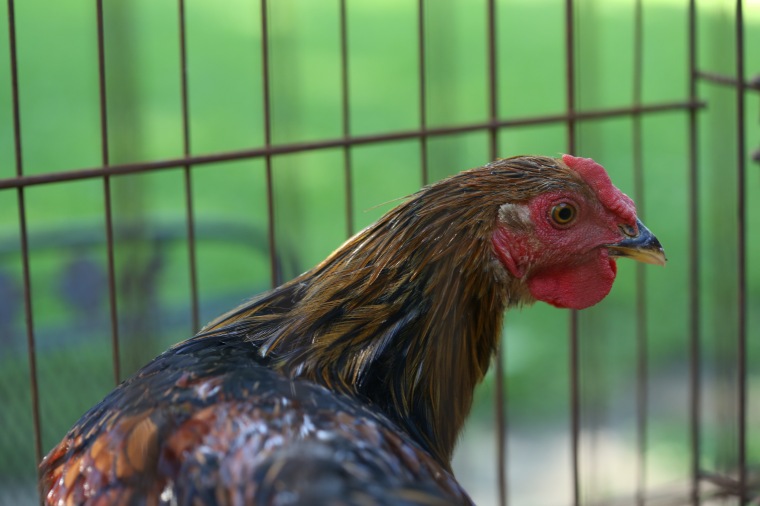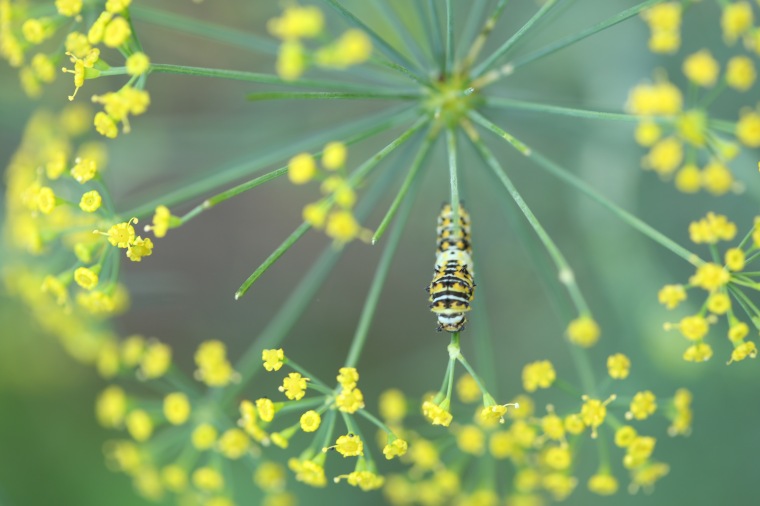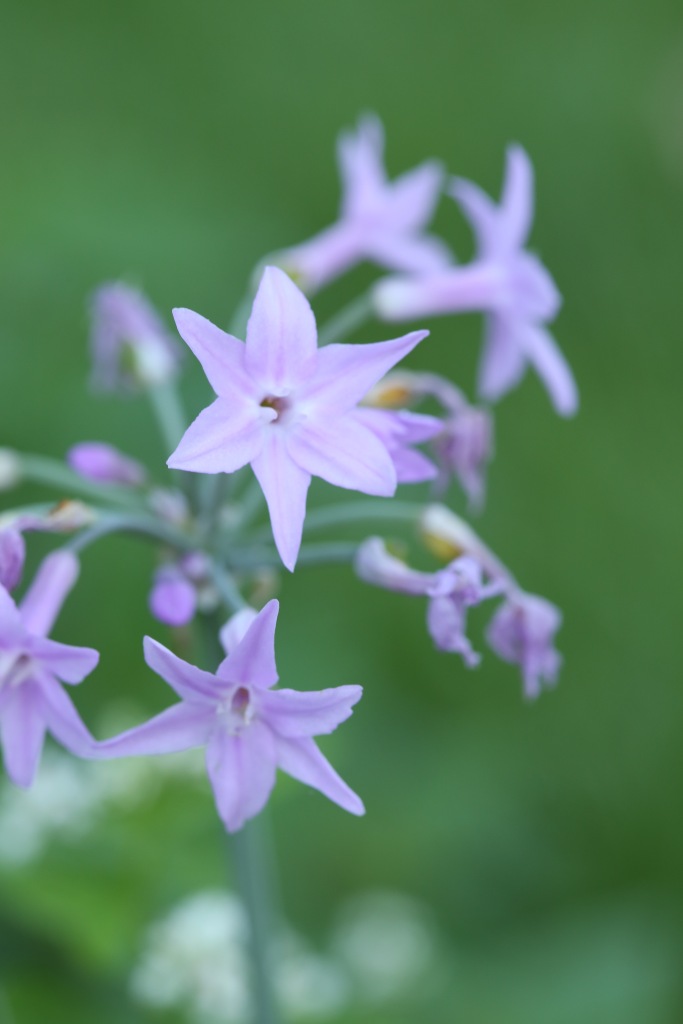
This summer has flown by so fast my head is spinning! Melissa from Corbin in the Dell and I are both posting about Fall Gardens today so be sure to follow the link to see her garden. While the garden has been productive this summer, it is still late in terms of harvesting produce. We are just now seeing the tomatoes ripen and squashes are slowly beginning to form on the vines. Even the peppers and eggplants are just now beginning to ripen while the few stalks of corn that survived are nearly ready to pick. Frost is still two months away and if we are lucky, we will see a real bounty during the month of October but overall, the whole straw bale gardening has been less successful than I had hoped.
One other factor we did not expect in our garden this year was deer. When we moved in, neighbors told us that deer would be visiting the garden but we never saw them. For months, nothing, not a nibble and then, they began visiting and of course, eating. Fencing in the garden has always been part of the plan, I have always wanted a true cottage style garden out front complete with a fence, gates and an arbor but it just isn’t in the budget this year-at least not one that is professionally installed. While I plan for something permanent, I had to take action in the short term to prevent more damage and I settled on a method I saw on an organic farm in Nashville several years ago.
Deer have poor depth perception, at least that is what I was told by the man who managed the farm and he said when you present them with obstacles, if they cannot judge the distances between them, they are not likely to move through them or jump over them. My solution is a series of boundaries made with twine and wooden stakes and so far, it is working.

These stakes are 60″ tall, the two layers of twine are approximately 4.5′ and 2′ off the ground and they completely surround the garden. We will be adding another layer behind this one with 8′ stakes and twine at the 7′ and 3.5′ levels, if all goes well, these layers of twine will cause enough confusion that the deer will stay out completely. Stay tuned for future posts with more on the fencing as well as the bales.
 The deer came into the garden to feed but oddly enough, they only ate leaves off of plants-not a single fruit! The damage to the sweet potatoes was pretty extensive but the vines are recovering. While the sweet potatoes were obviously the favorite choice, squash, tomatoes, peppers, eggplants, okra and beans also saw damage but oddly enough, the corn was avoided altogether.
The deer came into the garden to feed but oddly enough, they only ate leaves off of plants-not a single fruit! The damage to the sweet potatoes was pretty extensive but the vines are recovering. While the sweet potatoes were obviously the favorite choice, squash, tomatoes, peppers, eggplants, okra and beans also saw damage but oddly enough, the corn was avoided altogether.
 Fall gardening means removing plants that are spent and replacing them with new starts. The potatoes vines were drying up and many had withered away so i broke down the bales and harvested the potatoes. What a disappointment! We had these plants in bales for a full 6 months and this was the size of the potatoes. We may just keep them for seed potatoes and try planting them in the beds again-they aren’t worth the trouble of cooking.
Fall gardening means removing plants that are spent and replacing them with new starts. The potatoes vines were drying up and many had withered away so i broke down the bales and harvested the potatoes. What a disappointment! We had these plants in bales for a full 6 months and this was the size of the potatoes. We may just keep them for seed potatoes and try planting them in the beds again-they aren’t worth the trouble of cooking.

We planted Yukon golds and Red Norland potatoes into 5 bales. Most of them rotted and never produced a thing but the few that did, mostly looked like that.

The entire harvest of oddly shaped and really small potatoes.

When you plant a garden to produce your own food, you quickly learn that in order to grow a large variety of vegetables and fruits, you must plant crops in every season if possible. Here in Virginia, we have a long growing season and I am planning to take advantage of the somewhat mild winters. My seeds are germinating quickly and should be in the beds soon and if all goes well, we should be picking greens in a month.

Because we will not see frost until the second week of November, I have started another crop of beans. These are some Asian long beans and I hope these do better than all of the other beans I tried to grow this summer because I did not get anything from those plants!
 By planting heirloom varieties, you can let some go to seed and have seeds for next year. This lettuce plant is flowering and I will collect the seeds when they are mature.
By planting heirloom varieties, you can let some go to seed and have seeds for next year. This lettuce plant is flowering and I will collect the seeds when they are mature.
 Not only is it important to keep the garden clean and free of debris that bad bugs can hide in, it is best to attract beneficial insects to help keep the bad ones in check. This preying mantis has been living in our cucumber vines and she has been snacking on stink bugs. She recently mated, and yes he was her dinner that night and soon, we hope to find an egg case in the garden. If we do, we will keep it in a bee cage in the garden over the winter so that we can have them in the garden next year.
Not only is it important to keep the garden clean and free of debris that bad bugs can hide in, it is best to attract beneficial insects to help keep the bad ones in check. This preying mantis has been living in our cucumber vines and she has been snacking on stink bugs. She recently mated, and yes he was her dinner that night and soon, we hope to find an egg case in the garden. If we do, we will keep it in a bee cage in the garden over the winter so that we can have them in the garden next year.
 Our hens have reached the 20 week mark and should be laying soon. To keep them healthy, they need to forage and get some exercise and Darry built them a series of tunnels. It was simple to do and it is not a permanent structure so we can rearrange them as needed.
Our hens have reached the 20 week mark and should be laying soon. To keep them healthy, they need to forage and get some exercise and Darry built them a series of tunnels. It was simple to do and it is not a permanent structure so we can rearrange them as needed.
To build them, he cut 6′ lengths of livestock fencing and formed hoops. He lined the hoops up and ziptied them together then used landscape pins to hold them in place.
 A close up shot of the tunnels. The chickens really do forage a lot in the tunnels. They have also dug up an area for dust baths.
A close up shot of the tunnels. The chickens really do forage a lot in the tunnels. They have also dug up an area for dust baths.
 We only let them out during the day and they will spend the majority of the time out there looking for bugs and eating grass.
We only let them out during the day and they will spend the majority of the time out there looking for bugs and eating grass.

Three of the hens at work.

Because the fencing has large openings, they will stick their heads out to reach for grass and insects near the tunnels.

And as it seems to be a tradition, it looks like the best tomatoes of the season will be picked in the compost pile. This happens every year because the compost is not getting hot enough to kill the seeds from the tomatoes we toss in there.
 These look like jelly bean cherries and most likely are sweet. Trader Joe’s sells packages of mixed heirloom tomatoes and small sweet cherries and when we are not picking our own, I buy those. Until they ripen, I will not know for sure but it really does not matter; ripe tomatoes picked from the vine are always better than anything from the store!
These look like jelly bean cherries and most likely are sweet. Trader Joe’s sells packages of mixed heirloom tomatoes and small sweet cherries and when we are not picking our own, I buy those. Until they ripen, I will not know for sure but it really does not matter; ripe tomatoes picked from the vine are always better than anything from the store!
Keep gardening friends and don’t forget to visit the Corbin in the Dell blog to see what Melissa is up to!
 About a month ago, our chickens came home from their temporary location. We decided to put the coop within the garden so that they can help us with insect control and composting and more importantly, to keep the dog away from their droppings-we won’t discuss her disgusting taste in snacks…
About a month ago, our chickens came home from their temporary location. We decided to put the coop within the garden so that they can help us with insect control and composting and more importantly, to keep the dog away from their droppings-we won’t discuss her disgusting taste in snacks… The garden itself is approximately 38 feet wide by 94 feet long, which makes it about 3500 square feet. That gave us plenty of room for the coop and pen as well as the tunnels. The first thing I did out there was dedicate an area for composting and it is just behind the wheel barrow.
The garden itself is approximately 38 feet wide by 94 feet long, which makes it about 3500 square feet. That gave us plenty of room for the coop and pen as well as the tunnels. The first thing I did out there was dedicate an area for composting and it is just behind the wheel barrow. It took us an entire weekend to paint the PVC, build the hoop frame and cover it with the poultry netting. Knowing that we can leave them outside during the day without worrying about hawks. The large pen has another purpose; we will store leaves in there and the chickens will help us compost them. They constantly dig in the leaves which helps break them up and because the leave droppings as they go, the nitrogen in them will also help with the composting process. It takes at least six months to break them down so we will have to be patient.
It took us an entire weekend to paint the PVC, build the hoop frame and cover it with the poultry netting. Knowing that we can leave them outside during the day without worrying about hawks. The large pen has another purpose; we will store leaves in there and the chickens will help us compost them. They constantly dig in the leaves which helps break them up and because the leave droppings as they go, the nitrogen in them will also help with the composting process. It takes at least six months to break them down so we will have to be patient. The hoops are attached to the coop so that we can leave their door open to give them access to the pen.
The hoops are attached to the coop so that we can leave their door open to give them access to the pen. If the chickens are going to help with insect control in the garden, they need to be able to walk through it but unfortunately, they could run into hawks and more importantly, they would make a mess of the beds. The solution; tunnels. We built them in Williamsburg so that they would have more space to roam and when we moved, we took them apart and moved them with us.
If the chickens are going to help with insect control in the garden, they need to be able to walk through it but unfortunately, they could run into hawks and more importantly, they would make a mess of the beds. The solution; tunnels. We built them in Williamsburg so that they would have more space to roam and when we moved, we took them apart and moved them with us. Starting at the far end of the pen, we are running the tunnels down the fence line and around the exterior edge of the garden. We may still let them out into the garden occasionally but not with out supervision.
Starting at the far end of the pen, we are running the tunnels down the fence line and around the exterior edge of the garden. We may still let them out into the garden occasionally but not with out supervision. We attached the fence hoops to the wire fencing with cable ties.
We attached the fence hoops to the wire fencing with cable ties. To keep them in place on the ground, we used lawn staples.
To keep them in place on the ground, we used lawn staples.














 It’s salad season in my garden. Well, specifically, it is lettuce season. Living in the south means that lettuce is a cool weather crop while all the other parts of a salad, like tomatoes or cucumbers, are warm weather crops. Luckily, it is always fresh egg season in the chicken coop!
It’s salad season in my garden. Well, specifically, it is lettuce season. Living in the south means that lettuce is a cool weather crop while all the other parts of a salad, like tomatoes or cucumbers, are warm weather crops. Luckily, it is always fresh egg season in the chicken coop! There are a dozen different salad greens in the garden right now. In the salad above are Bloomsdale spinach, baby beet greens, parsley, salad bowl leaf lettuce, buttercrunch, forellenschluss and arugula.
There are a dozen different salad greens in the garden right now. In the salad above are Bloomsdale spinach, baby beet greens, parsley, salad bowl leaf lettuce, buttercrunch, forellenschluss and arugula. Simply dressed with vinaigrette, garnished with cherry tomatoes, cucumbers and some kalamata olives and served with the paper; my idea of lunch.
Simply dressed with vinaigrette, garnished with cherry tomatoes, cucumbers and some kalamata olives and served with the paper; my idea of lunch.



 Of course, adding a hard boiled egg from one of our golden laced wyandotte hens and a slice of bread makes it a light, refreshing meal perfect for any season.
Of course, adding a hard boiled egg from one of our golden laced wyandotte hens and a slice of bread makes it a light, refreshing meal perfect for any season.







































